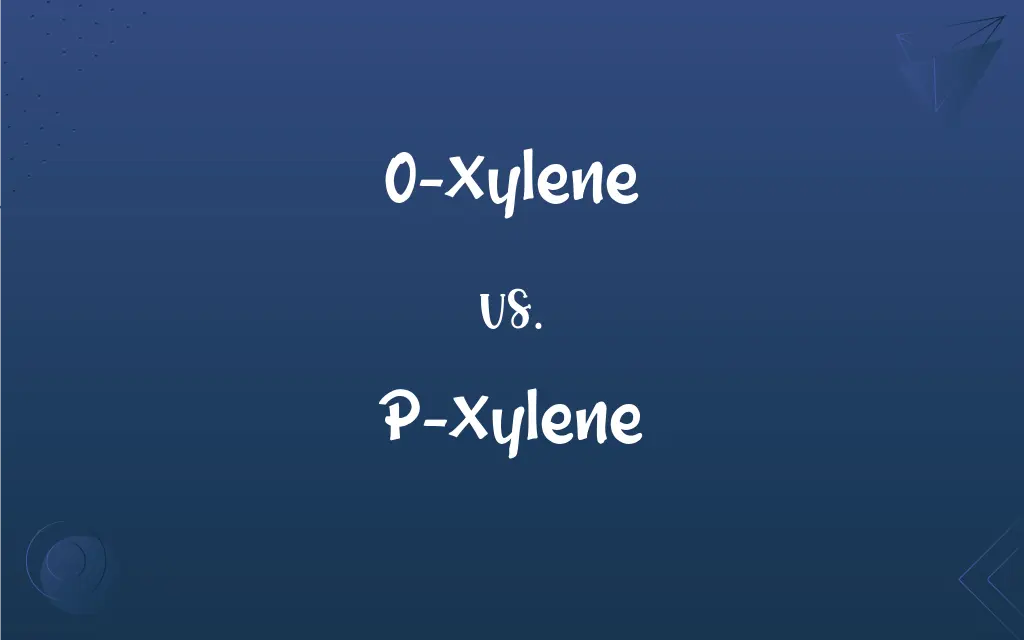O-Xylene vs. P-Xylene: What's the Difference?
Edited by Aimie Carlson || By Janet White || Published on November 14, 2024
O-Xylene features two methyl groups attached to the benzene ring at adjacent positions (1,2-), while p-Xylene's methyl groups are at opposite ends (1,4-), affecting their physical properties and reactivity.

Key Differences
O-Xylene, with its methyl groups on adjacent carbon atoms of the benzene ring, exhibits higher reactivity due to the closer proximity of the substituents, influencing its chemical behavior and applications. In contrast, p-Xylene's methyl groups are positioned at the para positions, making it more symmetrical and less reactive compared to o-xylene. This structural difference imparts distinct boiling points, with o-xylene boiling at a slightly lower temperature than p-xylene due to the less symmetric structure leading to weaker intermolecular forces.
In terms of applications, o-xylene is often used in the production of phthalic anhydride, an important chemical for making dyes and plasticizers. P-Xylene, on the other hand, is predominantly used in the manufacture of terephthalic acid and dimethyl terephthalate, key precursors for the polyester PET, highlighting the impact of structural differences on industrial uses.
The presence of methyl groups in o-xylene results in a denser electron cloud around the ortho positions, enhancing its reactivity in electrophilic aromatic substitution reactions compared to p-xylene, where the electron density is more evenly distributed. Additionally, the symmetrical structure of p-xylene contributes to its higher melting point, as its molecules can pack more efficiently in the solid state, unlike the less orderly arrangement seen with o-xylene.
Despite their similarities as isomers of dimethylbenzene, o-xylene and p-xylene's differing physical and chemical properties due to their methyl group placements have significant implications for their reactivity, boiling and melting points, and suitability for various chemical synthesis processes and industrial applications.
Comparison Chart
Molecular Structure
Methyl groups at adjacent (1,2-) positions
Methyl groups at opposite (1,4-) positions
ADVERTISEMENT
Boiling Point
Slightly lower due to less symmetric structure
Higher due to more symmetric structure
Reactivity
Higher due to closer proximity of methyl groups
Lower due to more even distribution of electron density
Applications
Production of phthalic anhydride
Production of terephthalic acid and dimethyl terephthalate
Melting Point
Lower, less efficient packing in solid state
Higher, more efficient packing in solid state
O-Xylene and P-Xylene Definitions
O-Xylene
O-Xylene's reactivity is enhanced by the proximity of its methyl groups.
It readily undergoes nitration to produce ortho-nitroxylene.
ADVERTISEMENT
P-Xylene
Its higher boiling point reflects a more symmetric molecular structure.
P-xylene boils at about 138°C.
O-Xylene
It has a lower boiling point due to its less symmetric structure.
O-xylene's boiling point is around 144°C.
P-Xylene
P-Xylene is a chemical compound with methyl groups at opposite ends of the benzene ring.
P-xylene is crucial for producing PET plastics.
O-Xylene
Its less orderly arrangement leads to a lower melting point.
O-xylene solidifies at a lower temperature compared to its isomers.
P-Xylene
P-Xylene is less reactive due to its symmetrical arrangement.
It is less prone to undergo electrophilic substitution reactions.
O-Xylene
Used in making dyes, it influences color properties in industrial applications.
O-xylene is processed into various dyes for textiles.
P-Xylene
The efficient packing in solid state gives it a higher melting point.
P-xylene melts at a higher temperature, making it more stable in solid form.
O-Xylene
O-Xylene is a volatile organic compound with adjacent methyl groups on the benzene ring.
O-xylene is a key ingredient in the synthesis of phthalic anhydride.
P-Xylene
It is a key precursor for polyester manufacturing.
P-xylene is converted into terephthalic acid for PET production.
FAQs
What are the primary industrial uses of o-xylene and p-xylene?
O-Xylene is mainly used in the production of phthalic anhydride, while p-xylene is used to manufacture terephthalic acid and dimethyl terephthalate.
Which is more reactive in chemical reactions, o-xylene or p-xylene?
O-Xylene is more reactive due to the closer proximity and interaction of its methyl groups.
How does the symmetry of p-xylene affect its physical properties?
The symmetry of p-xylene contributes to a higher melting point and boiling point due to more efficient molecular packing and stronger intermolecular forces.
Why is p-xylene preferred for making PET plastics?
P-Xylene is a precursor to terephthalic acid, a key component in PET plastic production, due to its suitable chemical structure for polymerization.
Can o-xylene and p-xylene be converted into each other?
Through complex chemical processes, it's theoretically possible but not practical due to their stable structures and the specificity of their synthesis routes.
Why does o-xylene have a lower boiling point than p-xylene?
The less symmetric structure of o-xylene leads to weaker intermolecular forces, resulting in a lower boiling point.
What distinguishes o-xylene from p-xylene in terms of chemical structure?
O-Xylene has methyl groups at adjacent positions on the benzene ring, while p-xylene's methyl groups are at opposite ends.
What role do o-xylene and p-xylene play in environmental considerations?
Both compounds are volatile organic compounds (VOCs) and contribute to air pollution; however, their impact and management depend on efficient industrial practices and regulatory standards to minimize emissions.
Which xylene isomer exhibits higher solubility in water, o-xylene or p-xylene?
Both o-xylene and p-xylene have very low solubility in water, with slight differences due to their structural variations, but generally, solubility is not significantly different between them.
Can the presence of o-xylene and p-xylene in the environment be harmful?
Yes, both can be harmful if released in large quantities, contributing to air and water pollution and posing health risks upon prolonged exposure.
How does the chemical industry utilize the differences between o-xylene and p-xylene?
The industry exploits these differences to produce specific chemicals; for example, o-xylene is primarily used for phthalic anhydride, and p-xylene for polyethylene terephthalate (PET) and other polymers.
How does the electron density distribution in o-xylene compare to p-xylene?
In o-xylene, the electron density is more concentrated around the ortho positions due to the proximity of the methyl groups, whereas in p-xylene, the electron density is more evenly distributed due to the symmetrical placement of methyl groups.
Why is p-xylene less reactive than o-xylene in electrophilic aromatic substitution reactions?
P-Xylene's methyl groups are positioned in a way that offers less steric hindrance to incoming electrophiles, making it relatively less reactive than o-xylene, where the adjacent methyl groups create more steric hindrance.
How do the physical properties of o-xylene and p-xylene influence their storage and transport?
Their volatility and flammability require careful handling, with storage in cool, well-ventilated areas away from sources of ignition and transport according to hazardous material regulations.
What are the environmental and health impacts of exposure to o-xylene and p-xylene?
Exposure can lead to respiratory, skin, and eye irritation, and long-term exposure may affect the central nervous system. Environmentally, they contribute to VOC emissions, impacting air quality and potentially causing ecological harm.
What impact does the placement of methyl groups have on the reactivity of xylene isomers?
The placement affects electron density and steric hindrance, influencing their susceptibility to electrophilic attack and reactivity in substitution reactions.
How does the industrial processing of o-xylene and p-xylene differ?
Processing depends on their end products; o-xylene is mainly oxidized to produce phthalic anhydride, while p-xylene undergoes processes to yield terephthalic acid or its derivatives.
What are the melting points of o-xylene and p-xylene, and how do they compare?
O-Xylene has a lower melting point due to its less efficient packing in the solid state, while p-xylene, being more symmetrical, has a higher melting point due to better molecular packing.
What safety measures are recommended when handling o-xylene and p-xylene?
Safety measures include using proper personal protective equipment (PPE), ensuring good ventilation, and adhering to handling and storage guidelines to prevent exposure and environmental release.
How are o-xylene and p-xylene separated in industrial settings?
They are separated by fractional distillation, leveraging their different boiling points, and through adsorption techniques using molecular sieves.
About Author
Written by
Janet WhiteJanet White has been an esteemed writer and blogger for Difference Wiki. Holding a Master's degree in Science and Medical Journalism from the prestigious Boston University, she has consistently demonstrated her expertise and passion for her field. When she's not immersed in her work, Janet relishes her time exercising, delving into a good book, and cherishing moments with friends and family.
Edited by
Aimie CarlsonAimie Carlson, holding a master's degree in English literature, is a fervent English language enthusiast. She lends her writing talents to Difference Wiki, a prominent website that specializes in comparisons, offering readers insightful analyses that both captivate and inform.







































































